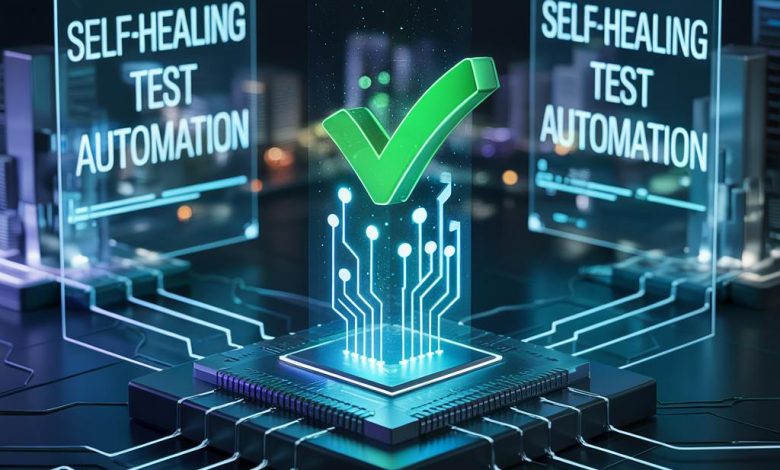Self-Healing Test Automation: The Future of Test Resilience

Overview of the Article
This article explains the concept of self-healing test automation, its underlying principles, benefits, and practical implementation strategies. It will explore the various techniques and technologies that enable self-healing capabilities, including machine learning algorithms, dynamic element locators, and visual validation methods, providing a comprehensive overview of the current state of the art in this rapidly evolving field. Furthermore, this article will discuss the challenges and limitations associated with self-healing test automation, such as the potential for false positives, the need for robust training data, and the importance of careful configuration and monitoring. It will also offer guidance on how to effectively implement self-healing test automation in different software development contexts, considering factors such as the size and complexity of the application, the frequency of releases, and the skill set of the testing team.
Introduction
Modern software development is characterized by an increasing velocity of releases, intricate system architectures, and an unwavering demand for impeccable user experiences, thereby intensifying the need for advanced test automation strategies.
The growing complexity of software systems, coupled with the imperative to deliver high-quality applications rapidly, necessitates a paradigm shift in how software testing is approached, moving from traditional, brittle automation frameworks to more adaptive and resilient solutions. Self-healing test automation represents a significant leap forward in this evolution, offering the promise of test scripts that can automatically adjust to changes in the application under test, thereby reducing maintenance overhead and improving the overall reliability of the testing process. In essence, self-healing test automation addresses the inherent limitations of conventional test automation, where even minor changes in the user interface or underlying code can render test scripts obsolete, leading to increased maintenance efforts and potential delays in the release cycle.
What is Self-Healing Test Automation?
Self-healing test automation is an innovative approach that leverages artificial intelligence and machine learning techniques to enable test scripts to automatically adapt to changes in the application under test. This adaptability is paramount in dynamic software environments, where continuous integration and continuous delivery (CI/CD) practices necessitate frequent updates and modifications, which can render traditional test automation scripts obsolete, leading to increased maintenance overhead and potential bottlenecks in the release pipeline. Traditional test automation relies on explicitly defined locators, such as XPath expressions or CSS selectors, to identify and interact with elements within the application’s user interface; however, these locators are often susceptible to even minor changes in the UI, causing test scripts to fail and requiring manual intervention to update the locators. Self-healing test automation mitigates this issue by employing intelligent algorithms that can identify elements based on multiple attributes, contextual information, and historical data, allowing the test script to automatically adjust to changes in the UI without requiring manual intervention.
The core principle behind self-healing test automation is the use of machine learning algorithms to analyze the application’s structure and behavior, identifying patterns and relationships that can be used to dynamically adjust test scripts in response to changes. By continuously monitoring the application and learning from past experiences, self-healing test automation systems can improve their ability to accurately identify elements and adapt to changes over time, reducing the need for manual intervention and improving the overall efficiency of the testing process.
Importance of Test Resilience
Test resilience is crucial in contemporary software development due to the increasing complexity and dynamism of software systems. The capacity of a test automation framework to gracefully manage alterations within the application under test, without precipitating test failures, is indispensable for upholding the integrity of continuous integration and continuous delivery (CI/CD) pipelines.
Self-healing test automation plays a pivotal role in fostering test resilience by enabling test scripts to automatically adapt to modifications in the application’s user interface or underlying code, thereby diminishing the necessity for manual intervention and augmenting the overall dependability of the testing process
Theoretical Foundations
The theoretical foundations of self-healing test automation are rooted in the principles of artificial intelligence, machine learning, and adaptive systems. At its core, self-healing test automation leverages machine learning paradigms, encompassing supervised, unsupervised, and reinforcement learning methodologies, to dissect the intricate architecture and operational dynamics of the application under scrutiny. Supervised learning algorithms are employed to train models that can predict the location and behavior of UI elements based on historical data, while unsupervised learning techniques can be used to identify patterns and anomalies in the application’s behavior that may indicate potential issues. Reinforcement learning algorithms can be used to optimize the test execution strategy, dynamically adjusting the test parameters to maximize coverage and minimize the risk of false positives.
Adaptive systems theory provides a framework for understanding how self-healing test automation systems can continuously learn and improve their performance over time. By incorporating feedback loops and mechanisms for self-evaluation, these systems can adapt to changes in the application and the testing environment, ensuring that the test scripts remain effective and reliable.
Principles of Self-Healing Systems
Self-healing test automation systems adhere to several core principles, including adaptability, resilience, and continuous learning. Adaptability is paramount, as the system must dynamically adjust to changes in the application under test, such as modifications to the user interface or underlying code. Resilience ensures that the system can continue to function effectively even in the face of unexpected errors or disruptions, such as network outages or server downtime.
Continuous learning is essential for improving the accuracy and reliability of the system over time, as the system learns from past experiences and adapts its behavior accordingly, with these principles enabling self-healing test automation systems to minimize the need for manual intervention and improve the overall efficiency of the testing process.
Adaptive and Resilient Testing Frameworks
Adaptive testing frameworks represent a paradigm shift in automated software testing, enabling the dynamic modification of test parameters and strategies contingent upon real-time feedback derived from the application under scrutiny. These frameworks employ sophisticated algorithms, including machine learning and statistical analysis, to discern patterns and anomalies in the application’s behavior, thereby enabling the proactive adjustment of test cases to address potential issues. Resilient testing frameworks are engineered to withstand unforeseen disruptions and errors, such as network outages, server downtime, or unexpected changes in the application’s behavior, which typically incorporate mechanisms for error detection, fault tolerance, and self-recovery, ensuring that the testing process can continue uninterrupted even in the face of adversity.
These mechanisms may include automatic retry logic, redundant test execution, and the ability to switch to alternative testing environments if necessary. The synergy between adaptive and resilient testing frameworks culminates in a robust and dependable automated testing solution that is capable of managing the intricacies of contemporary software systems while maintaining optimal performance and efficacy.
Advances in Machine Learning for Test Automation
Recent advancements in machine learning have paved the way for more sophisticated and effective self-healing test automation solutions, with machine learning algorithms now capable of automatically identifying and adapting to changes in the application’s user interface, reducing the need for manual intervention and bolstering the robustness of automated test suites. Sophisticated techniques, including but not limited to, image recognition, natural language processing, and optical character recognition, empower self-healing systems to discern and interpret UI elements within an application, thereby enabling the system to comprehend the contextual relevance of these elements, this capability proving especially invaluable when dealing with dynamic or complex user interfaces that undergo frequent modifications.
Furthermore, machine learning algorithms can be trained to predict the behavior of UI elements based on historical data, enabling the system to anticipate potential issues and proactively adjust the test scripts to mitigate risks and machine learning algorithms being leveraged to analyze test execution data, pinpointing patterns and anomalies that may indicate potential defects in the application. Machine learning integration facilitates an agile development environment by significantly curtailing failure rates, diminishing error occurrences, and preventing system breakdowns, ultimately culminating in substantial cost reductions and marked enhancements in overall quality. The automation of analysis and failure detection catalyzes a cycle of continuous improvement, enabling companies to identify and rectify defects more efficiently, leading to enhanced product stability and user satisfaction.
The successful deployment of machine learning in test automation necessitates careful consideration of several critical factors, including the selection of appropriate algorithms, the quality and quantity of training data, and the potential for overfitting or bias.
Current Research and Trends
Current research in self-healing test automation is focused on developing more robust and adaptive systems that can handle the increasing complexity of modern software applications. One promising avenue of exploration involves the application of reinforcement learning techniques to empower test automation systems with the capacity to autonomously adapt to alterations within the application under scrutiny, this approach entailing the training of an agent to interact with the application in a manner akin to a human tester, thereby enabling the agent to acquire knowledge regarding the application’s behavior and formulate optimal testing strategies.
Another area of focus is the development of self-healing systems that can automatically generate test cases based on the application’s code or specifications. These systems employ techniques such as symbolic execution and model checking to identify potential defects and generate test cases that can effectively expose these defects. Industry collaboration and engagement are also vital for advancing the field, despite the prevalent use of tools like Tosca, Selenium, many lack open-source availability, emphasizing the need for greater accessibility and cooperation to foster innovation and widespread adoption. As agile development and continuous delivery methodologies gain traction, the demand for self-healing test automation solutions will continue to grow.
Organizations are recognizing the importance of test automation maturity and are actively seeking ways to improve their testing practices, with self-assessment tools playing a crucial role in identifying areas for improvement and guiding the implementation of more effective test automation strategies. The progressive integration of artificial intelligence and machine learning techniques is becoming increasingly indispensable for optimizing the efficacy and reliability of software testing protocols, thereby facilitating the accelerated delivery of high-quality software applications.
Emerging Techniques in Self-Healing Test Automation
The ongoing evolution of software development necessitates that testing methodologies adapt accordingly, with innovative techniques emerging to address the limitations of traditional test automation approaches. One such technique is visual validation, which involves using image recognition algorithms to compare the actual output of the application under test with a baseline image, enabling the system to detect subtle UI changes that might be missed by traditional assertion-based tests. Another promising technique is the use of semantic analysis to understand the meaning of test scripts and automatically update them when the application changes.
Additionally, the convergence of AI with automated software testing is transforming the landscape of quality assurance, by providing faster and more reliable identification of bugs and errors, this integration reduces the need for human intervention and enhances the overall efficiency of the testing process Future development efforts should therefore prioritize the creation of more intuitive and user-friendly automated solutions that minimize false positives and streamline operational workflows, thereby fostering greater adoption and satisfaction among software developers and QA teams.
The integration of AI in software testing marks a significant advancement, offering tools capable of autonomously detecting code defects at speeds surpassing human capabilities.
Challenges and Limitations of Existing Approaches
Despite the potential benefits of self-healing test automation, there are also several challenges and limitations that need to be addressed. One major challenge is the complexity of implementing and maintaining self-healing systems. Even with self-healing capabilities, a solid foundation of well-designed and meticulously maintained test automation frameworks is crucial because self-healing test automation augments testing resilience; it does not substitute for robust testing frameworks.
Another challenge is the risk of false positives and false negatives. Self-healing systems may incorrectly identify changes as being benign or may fail to detect actual defects. Another limitation is that self-healing test automation is not a silver bullet. It cannot supplant the nuanced insights and adaptability that human testers bring to the process, particularly in exploratory testing scenarios or when assessing the user experience, as the technology serves as a powerful complement to, rather than a complete replacement of, traditional testing methodologies, augmenting testing resilience and efficiency.
The selection of appropriate algorithms, the quality and quantity of training data, and the potential for overfitting or bias are critical factors to consider for the successful deployment of machine learning in test automation, emphasizing that human oversight remains essential for ensuring the accuracy and reliability of AI-driven testing processes.
Organizations need to overcome challenges such as a lack of understanding about what a particular type of AI technology can or cannot do, a lack of clear strategies for integrating different AI technologies into existing systems, a shortage of a well-trained workforce for AI implementation, and potential incompatibilities between AI technologies and existing legacy infrastructure; furthermore, a significant impediment lies in the limited availability of high-quality, diverse datasets essential for effectively training machine learning algorithms.
The need to carefully consider both the capabilities and the limitations of AI and machine learning technologies to ensure meaningful and effective human control and judgment over them is paramount. One of the major problems with using AI systems is that AI systems may produce errors, exhibit bias, be sensitive to noise in the data, and often lack technical and judicial transparency, resulting ina reduction in trust and challenges in their adoption
Case Studies of Self-Healing Test Implementation
Examining real-world applications of self-healing test automation provides valuable insights into its practical benefits and challenges, especially in industries with stringent safety and regulatory demands, such as autonomous vehicles, which shows the paramount importance of thorough testing and validation protocols. For example, the adaptive cruise control system is an intelligent system to make cars drive automatically by interacting with the driving environment and learning the corresponding driving behaviors, such as speeding up, slowing down, and braking.
The implementation of self-healing test automation has proven particularly beneficial in dynamic and agile development environments, where frequent software updates can lead to test script breakage and maintenance overhead.
For example, in the domain of web application testing, one company implemented a self-healing solution that automatically updated test scripts when UI elements changed, resulting in a significant reduction in test maintenance time and improved test coverage. In another case study, a mobile app development team used AI-powered test automation to detect and fix UI issues across different devices and screen sizes, leading to a faster release cycle and a higher quality product. To ensure the trustworthiness of AI models, testing frameworks have been developed and successfully applied to identify faults, biases, and vulnerabilities, reinforcing the crucial role of testing in enhancing the reliability of software systems.
However, it is crucial to acknowledge that the efficacy of self-healing test automation hinges on the quality of the underlying algorithms and training data, necessitating careful consideration of potential biases and limitations. Certain sophisticated tools have showcased notable effectiveness in the rigorous examination of industrial AI models, playing a pivotal role in the identification of intricate anomalies and inherent weaknesses within these complex systems.
Future Directions
Future directions in self-healing test automation point towards more sophisticated AI-driven solutions that can autonomously adapt to changes in the software under test. The convergence of machine learning methodologies, such as deep learning and reinforcement learning, holds immense promise for bolstering the adaptability and resilience of self-healing systems, enabling them to derive insights from historical test failures and proactively conform to the ever-changing software ecosystem, as the testing community increasingly looks to AI to bridge gaps created by the continuous integration and continuous delivery pipeline by checking code for errors more efficiently than humans.
The integration of AI into software engineering has initiated transformative shifts across critical functions such as defect detection, software-defined networking, software testing, and maintenance, with AI methodologies demonstrating the potential to significantly augment efficiency, precision, and flexibility within these domains.
The role of AI is expanding across diverse fields, including healthcare and education, by automating intricate tasks, improving decision-making processes, and enabling customized learning experiences. As AI technologies advance, their incorporation into educational settings offers inventive approaches to enhance teaching and learning, demonstrating the vast potential of AI-driven instruments to transform education and enhance student results.
Integrating Self-Healing into Continuous Integration and Delivery
The integration of self-healing test automation into CI/CD pipelines represents a paradigm shift towards more resilient and efficient software delivery processes. By proactively identifying and resolving test failures in real-time, self-healing tests minimize the manual intervention required to maintain test suites, thereby accelerating feedback loops and facilitating more frequent and reliable software releases. As continuous integration and continuous delivery practices become more widespread, projects that embrace automated testing report an increased number of test cases, along with improvements in code quality attributed to enhanced testing procedures integrated into the CI/CD pipeline. The growing popularity of CI and DevOps, along with the increasing volume and complexity of data involved in these processes, has motivated researchers to propose Machine Learning-based solutions for automating CI phases, taking one more step toward enabling the AIOps. Furthermore, the capacity of AI-driven systems to autonomously identify irregularities within deployed applications leads to a marked enhancement in the effectiveness of comprehensive system monitoring.
The goal of the CI process is to catch and fix issues and bugs early in the development process before they become major problems that are harder and more expensive to resolve.
Scaling Self-Healing Capabilities Across Complex Systems
Scalability of self-healing features to a large-scale system is a challenge indeed, especially in a distributed environment when the test runs on multiple nodes and platforms. These sophisticated methods make it possible to derive predictions on the outcome of complex tasks from historical data or trends, enabling developers to act before problems arise and grow, and thus improving the general resilience of systems. Four ReliAble Monitor and Diagnose Features In order to properly identify the root cause of test failures and to take appropriate corrective action, successful self-healing strategies must include powerful monitoring and diagnosis capabilities.
The further testing progresses into the field of machine learning/ artificial intelligence, the more AI becomes a part of the solution of the challenges faced within the various testing phases, through logical reasoning, problem solving and ML, to complex problems and user responsibilities. In addition, AI could aid developers in finding the best branching patterns to reduce ambiguity and make integration easier, reducing the overall cost of collaboration on software development. Finally, self-healing test automation can be achieved through a combination of technology innovation, process optimization, and organizational realignment, leading to a future where software testing stops being about just catching bugs but also becomes the proactive facilitator of continuous delivery and innovation.
Ethical Considerations and Responsible AI Deployment
As self-healing test automation systems become increasingly autonomous, it is imperative to address the ethical considerations surrounding their deployment and ensure responsible AI practices. Careful attention must be paid to potential pitfalls, including automation bias that could lead to skewed testing outcomes, over-reliance on automated systems that might diminish human oversight, and critical data privacy concerns that arise from the collection and analysis of test data. It’s critical to establish frameworks that strike a balance between autonomy and accountability, ensuring that all stakeholders can leverage the potential of agentic AI while preserving trust, fairness, and societal welfare.
Explainable AI techniques play a crucial role in enhancing the transparency and interpretability of self-healing decisions, enabling developers and testers to understand why a particular corrective action was taken and validate its effectiveness. To ensure the reliability and trustworthiness of AI systems, especially in critical applications, it is essential to address accuracy, transparency, and fairness. By shedding light on the decision-making processes of AI algorithms, explainable AI promotes greater confidence and acceptance of self-healing automation within software development teams.
Without guiding principles, the application of AI in critical areas such as health, finances, and criminal justice will perpetuate the same biases in human thinking, thus robbing the technology of its potential to create new systems that enlighten and augment human intelligence to correct social wrongs. Therefore, developers must implement ethical guidelines, ensuring that AI systems do not amplify existing societal biases or introduce new forms of discrimination.
In conclusion, the journey towards self-healing test automation represents a paradigm shift in software testing, empowering organizations to build more resilient, reliable, and high-quality software systems. By leveraging the power of AI and machine learning, self-healing test automation enables organizations to accelerate their software delivery pipelines, reduce testing costs, and improve the overall quality of their products. Given the increasing integration of AI into critical infrastructure and decision-making processes, it is imperative to cultivate trust through transparency, explainability, and adherence to ethical standards, thereby fostering confidence in the technology’s reliability and societal benefit.








